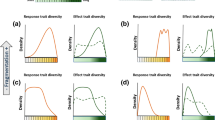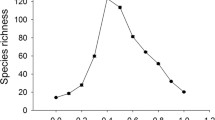Abstract
Although recent studies have revealed that the relationship between diversity and environmental heterogeneity is not always positive, as classical niche theory predicts, scientists have had difficulty interpreting these results from an ecological perspective. We propose a new concept—microfragmentation—to explain how small-scale heterogeneity can have neutral or even negative effect on species diversity. We define microfragmentation as a community level process of splitting habitat into a more heterogeneous environment that can have non-positive effects on the diversity through habitat loss and subsequent isolation. We provide support for the microfragmentation concept with results from spatially explicit heterogeneity–diversity model simulations, in which varying sets of species (with different ratios of specialist and generalist species) were modeled at different levels of configurational heterogeneity (meaning that only the habitat structure was changed, not its composition). Our results indicate that environmental heterogeneity can affect community diversity in the same way as fragmentation at the landscape level. Although generalist species might not be seriously affected by microfragmentation, the persistence of specialist species can be seriously disturbed by small-scale patchiness. The microfragmentation concept provides new insight into community level diversity dynamics and can influence conservation and management strategies.





Similar content being viewed by others
References
Allouche O, Kadmon R (2009) A general framework for neutral models of community dynamics. Ecol Lett 12:1287–1297
Armstrong RA, McGehee R (1980) Competitive exclusion. Am Nat 115:151–170
Baer SG, Blair JM, Collins SL, Knapp AK (2004) Plant community responses to resource availability and heterogeneity during restoration. Oecologia 139:617–629
Begon M, Harper JL, Townsend CR (2006) Ecology: individuals, populations and communities, 4th edn. Blackwell, Oxford
Bell G, Lechowicz MJ, Waterway MJ (2000) Environmental heterogeneity and species diversity of forest sedges. J Ecol 88:67–87
Berkley HA, Kendall BE, Mitarai S, Siegel DA (2010) Turbulent dispersal promotes species coexistence. Ecol Lett 13:360–371
Cousins SAO, Eriksson O (2001) Plant species occurrences in a rural hemiboreal landscape: effects of remnant habitats, site history, topography and soil. Ecography 24:461–469
Cramer MJ, Willig MR (2005) Habitat heterogeneity, species diversity and null models. Oikos 108:209–218
Davies KF, Chesson P, Harrison S, Inouye BD, Melbourne BA, Rice KJ (2005) Spatial heterogeneity explains the scale dependence of the native-exotic diversity relationship. Ecology 86:1602–1610
Duelli P (1997) Biodiversity evaluation in agricultural landscapes: an approach at two different scales. Agric Ecosyst Environ 62:81–91
Ettema CH, Wardle DA (2002) Spatial soil ecology. Trends Ecol Evol 17:177–183
Fahrig L (2003) Effects of habitat fragmentation on biodiversity. Annu Rev Ecol Evol Syst 34:487–515
Fahrig L, Baudry J, Brotons L, Burel FG, Crist TO, Fuller RJ, Sirami C, Siriwardena GM, Martin J-L (2011) Functional landscape heterogeneity and animal biodiversity in agricultural landscapes. Ecol Lett 14:101–112
Franklin AB, Noon BR, George TL (2002) What is habitat fragmentation? Stud Avian Biol 25:20–29
Gardner RH, Engelhardt KAM (2008) Spatial processes that maintain biodiversity in plant communities. Perspect Plant Ecol Evol Syst 9:211–228
Gignac LD, Dale MRT (2005) Effects of fragment size and habitat heterogeneity on cryptogam diversity in the low-boreal forest of western Canada. Bryologist 108:50–66
Griffin JN, Jenkins SR, Gamfeldt L, Jones D, Hawkins SJ, Thompson RC (2009) Spatial heterogeneity increases the importance of species richness for an ecosystem process. Oikos 118:1335–1342
Harrison S, Cornell H, Moore KA (2010) Spatial niches and coexistence: testing theory with tarweeds. Ecology 91:2141–2150
Helm A, Hanski I, Partel M (2006) Slow response of plant species richness to habitat loss and fragmentation. Ecol Lett 9:72–77
Hortal J, Triantis KA, Meiri S, Thebault E, Sfenthourakis S (2009) Island species richness increases with habitat diversity. Am Nat 174:E205–E217
Hubbell SP (2005) Neutral theory in community ecology and the hypothesis of functional equivalence. Funct Ecol 19:166–172
Huston MA (1994) Biological diversity: the coexistence of species on changing landscape. Cambridge University Press, Cambridge
Hutchinson GE (1957) Concluding remarks. Cold Spring Harbour Symp Quant Biol 22:415–427
Kadmon R, Allouche O (2007) Integrating the effects of area, isolation, and habitat heterogeneity on species diversity: a unification of island biogeography and niche theory. Am Nat 170:443–454
Kallimanis AS, Mazaris AD, Tzanopoulos J, Halley JM, Pantis JD, Sgardelis SP (2008) How does habitat diversity affect the species-area relationship? Glob Ecol Biogeogr 17:532–538
Kassen R (2002) The experimental evolution of specialists, generalists, and the maintenance of diversity. J Evol Biol 15:173–190
Kati V, Poirazidis K, Dufrêne M, Halley JM, Korakis G, Schindler S, Dimopoulos P (2010) Towards the use of ecological heterogeneity to design reserve networks: a case study from Dadia National Park, Greece. Biodivers Conserv 19:1585–1597
Kotiaho JS, Kaitala V, Komonen A, Paivinen J (2005) Predicting the risk of extinction from shared ecological characteristics. Proc Natl Acad Sci USA 102:1963–1967
Laanisto L, Urbas P, Partel M (2008) Why does the unimodal species richness-productivity relationship not apply to woody species: a lack of clonality or a legacy of tropical evolutionary history? Glob Ecol Biogeogr 17:320–326
Lundholm JT (2009) Plant species diversity and environmental heterogeneity: spatial scale and competing hypotheses. J Veg Sci 20:377–391
Lundholm JT, Larson DW (2003) Relationships between spatial environmental heterogeneity and plant species diversity on a limestone pavement. Ecography 26:715–722
Manthey M, Fridley JD, Peet RK (2011) Niche expansion after competitor extinction? A comparative assessment of habitat generalists and specialists in the tree floras of south-eastern North America and south-eastern Europe. J Biogeogr 38:840–853
Palmer MW (1992) The coexistence of species in fractal landscapes. Am Nat 139:375–397
Partel M, Laanisto L, Wilson SD (2008) Soil nitrogen and carbon heterogeneity in woodlands and grasslands: contrasts between temperate and tropical regions. Glob Ecol Biogeogr 17:18–24
Plotnick RE, Gardner RH (2002) A general model for simulating the effects of landscape heterogeneity and disturbance on community patterns. Ecol Model 147:171–197
Reynolds HL, Haubensak KA (2009) Soil fertility, heterogeneity, and microbes: towards an integrated understanding of grassland structure and dynamics. Appl Veg Sci 12:33–44
Reynolds HL, Mittelbach GG, Darcy-Hall TL, Houseman GR, Gross KL (2007) No effect of varying soil resource heterogeneity on plant species richness in a low fertility grassland. J Ecol 95:723–733
Rosenzweig ML (1995) Species diversity in space and time. Cambridge University Press, Cambridge
Saunders DA, Hobbs RJ, Margules CR (1991) Biological consequences of ecosystem fragmentation—a review. Conserv Biol 5:18–32
Smith TW, Lundholm JT (2012) Environmental geometry and heterogeneity–diversity relationships in spatially explicit simulated communities. J Veg Sci. doi:10.1111/j.1654-1103.2011.01380.x
Sparrow AD (1999) A heterogeneity of heterogeneities. Trends Ecol Evol 14:422–423
Tamme R, Hiiesalu I, Laanisto L, Szava-Kovats R, Partel M (2010) Environmental heterogeneity, species diversity and co-existence at different spatial scales. J Veg Sci 21:796–801
Tews J, Brose U, Grimm V, Tielbörger K, Wichmann MC, Schwager M, Jeltsch F (2004) Animal species diversity driven by habitat heterogeneity/diversity: the importance of keystone structures. J Biogeogr 31:79–92
Tienderen PHV (1991) Evolution of generalists and specialist in spatially heterogeneous environments. Evolution 45:1317–1331
Whitcomb S, Stutz JC (2007) Assessing diversity of arbuscular mycorrhizal fungi in a local community: role of sampling effort and spatial heterogeneity. Mycorrhiza 17:429–437
Williams CB (1964) Patterns in the balance of nature. Academic, New York
With KA, Crist TO (1995) Critical thresholds in species responses to landscape structure. Ecology 76:2446–2459
Acknowledgments
This research was supported by the European Union 7th framework project SCALES, FP7-226852; European Union 6th framework project ECOCHANGE, FP6-036866; European Regional Development Fund, Centre of Excellence FIBIR, ERMOS program (Grant 14, co-funded by Marie Curie Actions), and Estonian Science Foundation (Grant 8323) and CSIC JAE DOC fellowship. The authors would like to thank the anonymous reviewers for their valuable comments and suggestions. Author contributions: L.L., R.T. and M.P. designed the study; L.L., M.P., I.H. and A.G. did the analysis; L.L., R.S.-K. and M.P. wrote the manuscript. All authors discussed the results and made substantial contributions to the manuscript.
Author information
Authors and Affiliations
Corresponding author
Additional information
Communicated by Bryan Foster.
Electronic supplementary material
Below is the link to the electronic supplementary material.
Rights and permissions
About this article
Cite this article
Laanisto, L., Tamme, R., Hiiesalu, I. et al. Microfragmentation concept explains non-positive environmental heterogeneity–diversity relationships. Oecologia 171, 217–226 (2013). https://doi.org/10.1007/s00442-012-2398-5
Received:
Accepted:
Published:
Issue Date:
DOI: https://doi.org/10.1007/s00442-012-2398-5




